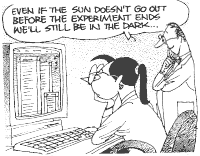 |
Mystery of the Sun's particles
|
 |
In 1967,an American scientist named Raymond Davies descended
into the Homestake Gold Mine in South Dakota,filled a huge metal tank with
140 tons of industrial cleaning fluid - and waited.He was looking for signs
of ghostly sub - atomic particles called neutrinos hitting the chlorine atoms
in the cleaning fluid and turning them into atoms of the inert gas argon
Davis's interest in these esoteric particles had been sparked
by the work of astronomers on unravelling the nuclear fusion reactions that
are the power source of the Sun.Neutrinos were expected to be a by-product
of these reactions,and as such could give Davis the first direct insights
of conditions at the core of our nearest star.
As the months went by,the neutrinos duly arrived although not
at the rate Davis expected.At first,it seemed that the dearth of neutrinos
might have been the result of not waiting long enough,or some quirk of the
experiment.But as the months turned into years and the years into decades,the
neutrinos still refused to arrive at the expected rate.
Today,the Homestake experiment is still running,and has been
joined by many others around the world.And they all find broadly the same
result: there is a 30 to 50 per cent shortfall in the number of neutrinos
coming from the Sun.
Theorists have come up with a range of theories to explain the
anomaly.Some lay the blame at the door of the Sun - that for some reason,its
core is cooler than expected,and so churning out fewer neutrinos.
One worrying suggestion is that the Sun's internal reactions
have actually stopped.As light from the inner regions of the Sun bounces
around many times inside it before reaching the surface,we would have no
inkling of this for millions of years.
Other,less dramatic - and more plausible - explanations point
the finger at the particles themselves,suggesting that they get up to some
monkey business on the journey from the Sun to Earth.
Now a team of Polish physicists have come up with the most radical
theory yet: that some of the neutrinos are breaking one of the golden rules
of physics and are travelling faster than light.
Einstein's
theory of relativity does not,in fact,prohibit faster-than-light travel:
only particles accelerating from a standing start to "superluminal"
speeds.If,however,a particle is born already travelling faster than
light,Einstein would have no problems with it.
This is what Jakub Rembielinski and his colleagues at Lodz
University are now proposing for neutrinos.One bizarre consequence of their
proposal is that neutrinos would no longer have mass in the conventional
sense.Instead,they have something called
"imaginary" mass,a variety of
mass that is in some sense at right angles to the ordinary kind.
Fortunately,while human intuition fails
completely when faced with such ideas, mathematics does not,and Rembielinski
has been able to calculate some of the implications of neutrinos possessing
imaginary mass.
One of them is that some types of neutrinos would become
unstable,decaying into other types that could evade detection by experiments
like those in South Dakota. According to
New
Scientist,the type of decay predicted could account more or less exactly
for the "missing" neutrinos.
The explanation comes with a hefty price-tag,however
- in the form of some odd consequences of superluminal travel.Most serious
is the problem of particles actually travelling backwards in time,reversing
cause and
effect.
Whether the scientific community can accept such possibilities in return
for solving the mystery of the missing neutrinos is as yet unclear.What is
clear, however,is that the suggestion is eerily similar to a description
that appears in the works of the First Century BC Roman poet and philosopher
Lucretius.
In his epic poem De rerum natura - "On the nature of
things" - he describes the nature of particles that come from the "inmost
depth" of the Sun."Surely," says Lucretius,"they must go all the faster and
the farther and traverse an extent of space many times as great in the time
it takes for the sunlight to flash across the sky?"
Only a little poetic licence is needed to see this as a virtually perfect
description of faster-than-light neutrinos from the solar core.A coincidence?
Perhaps.But then again,perhaps the spooky prescience of Lucretius is evidence
for the existence of superluminal particles that can travel back in time.